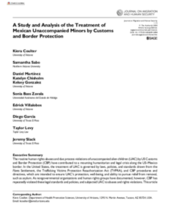Displaying 611 - 620 of 2215
Haitian prosecutors have begun a criminal investigation into children's homes run by the Church of Bible Understanding in the United States, which held 154 children at the time of a February 13th fire that killed 13 children, according to this article from the Associated Press.
This article outlines key research on how motivational interviewing is an approach that strengthens positive youth development and can improve youth’s engagement in skills, resources, and services as they age out of foster care.
This article draws from surveys of 97 recently deported Mexican unaccompanied alien children (UAC), which examine their experiences with US immigration authorities. The study finds that Mexican UAC are detained in subpar conditions, are routinely not screened for fear of return to their home countries or for human trafficking, and are not sufficiently informed about the deportation process.
This webinar features a panel of LGBTQ foster care alumni dedicated to creating change in the child welfare system.
A cost analysis was conducted as part of a 5-year, federally funded statewide demonstration project to install universal trauma screening in one U.S. state’s child welfare system.
Framed by relational dialectics theory, a contrapuntal analysis of 104 photolistings examined the discursive tensions of what it means to be an “adoptable” child.
The aim of the study was to document mental health service use (counseling and medication) among youth in foster care, examine how prepared they feel to manage their mental health, and investigate predictors of service use and preparedness.
This article interrogates formal public evaluations of extended care programmes with a particular focus on their eligibility criteria that have determined which groups of care leavers are included or alternatively excluded and the identified strengths and limitations of the programmes.
This quantitative study investigated how selected attributes of children (e.g., gender) and their microsystems (e.g., caregiving settings) related to the receipt of special education among a sample of 1855 child welfare-involved youth from the U.S. National Survey of Child and Adolescent Well-Being II.
"Twenty-seven migrant children in government custody had tested positive for coronavirus as of Monday, according to the latest update from the Office of Refugee Resettlement, the federal agency charged with their care," says this article from CNN.

